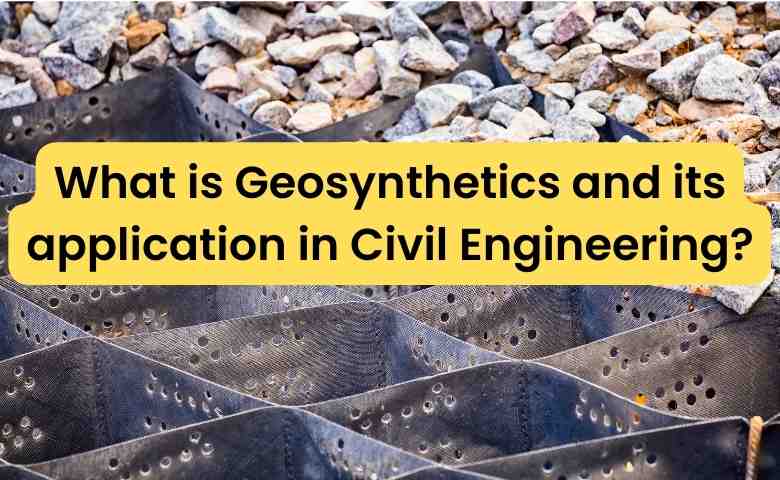Last Updated on March 7, 2024 by Admin
Geosynthetics are a heterogeneous class of materials that includes geotextiles, geomembranes, and geopolymers. Geosynthetics are gaining acceptance in civil engineering due to their ability to provide cost-effective solutions for many problems. They can be used to support weak foundations, act as barriers to contain hazardous materials and waste, or offer solutions to soil erosion. This article is about geosynthetics’ uses and applications in civil engineering.
Geosynthetics are artificial synthetic materials in the shape of strips, sheets, or three-dimensional structures constructed of polymeric or natural materials. They are simple to prepare and transport, and they can aid in the greening of construction projects. When used in construction, they serve five critical functions: separation, reinforcement, filtration, drainage, and containment.
Geosynthetics is a term that refers to a variety of polymeric compounds that are employed in Civil Engineering construction projects. The word is commonly used to refer to eight different types of items. Geotextiles and geomembranes are the most often utilized geosynthetics. Geotextiles, geogrids, geonets, geomembrane, geosynthetic clay liners, geofoam, geocells, and geocomposite are used.
Numerous civil engineering projects rely on geosynthetics, specialty nonwovens used in civil engineering. Nonwovens are utilized in building motorways, airfields, railways, sports fields, drainage trenches, dams, and dykes for separation, strengthening, and filtering. Despite their hardness and sturdiness, they are laid to create a roll and are light and easy to handle.
Table of Contents
What are Geosynthetics?
Geotextiles are permeable textile fabrics used in contact with soil, rock, earth, or any other geotechnical-related material as part of a civil engineering project, structure, or system, according to ASTM (1994).
Geomembrane is a fundamentally impermeable membrane that is commonly used as cut-offs and liners in the form of a produced sheet. They’re frequently utilized as landfill liners.
Image: What are Geosynthetics?
Geotextiles are permeable textile materials employed as part of a civil engineering project, structure, or system in contact with soil, rock, earth, or other geotechnical-related material.
A geogrid is a unidirectional or bidirectional polymeric structure in the form of a manufactured sheet that consists of a regular network of integrally connected elements linked by extrusion, bonding and whose openings are more significant than the constituents used in geotechnical, environmental, hydraulic, and transportation engineering applications.
A geonet is a polymeric structure that takes the shape of a produced sheet and comprises a regular network of integrally connected overlapping ribs with holes that are typically larger than the constituents.
A geocomposite is a composite material of at least one geosynthetic used in geotechnical, environmental, and transportation engineering applications.
A geomat is a polymeric structure in a produced sheet made up of non-regular networks of fibers, yarns, filament, tapes, or other thermally or mechanically coupled materials. It has more significant gaps than its constituents.
A geocell is a polymeric cellular structure of open networks of connecting strips connected by extrusion, adhesion, or other means.
Geotextiles are one of the most flexible and cost-effective ground improvement materials available. Their application has spread fast throughout civil, geotechnical, environmental, coastal, and hydraulic engineering.
Related Posts:
- Top Books on Advanced Geotechnical Engineering
- Geotechnical Engineer Job Description and Salary Details
- Books on Geotechnical Engineering For Students and Engineers
- How to Protect Your Foundation from Water Damage
Geosynthetics in Engineering
Geo-environmental engineering is the branch of engineering that deals with applying geotechnical methods to environmental issues. Some examples include contamination site clean-up, water resource engineering, wastewater treatment, waste processing and storage, pollution control, coastal rebuilding, protection and preservation, and flood control.
In this realm of applications, geosynthetics are becoming increasingly important. Geosynthetics are polymeric materials, either synthetic or natural, employed in interaction with soil, rock, and/or other geotechnical materials. Polyethylene, polypropylene, polyester, and polyvinyl chloride are the most common polymers.
However, specific polymers (e.g., linear low-density polyethylene octane- or hexane-copolymers, high-molecular-weight polyethylene terephthalate with low carboxyl end groups) and related additive packages (e.g., antioxidant packages) are chosen within each class to best suit the intended application.
Geosynthetics are most commonly used in geotechnical and geo-environmental engineering, while they are also used in other sectors of civil engineering, such as waterproofing building structures.
The Application of Geosynthetics in Civil Engineering
Geosynthetics are one of the most flexible and cost-effective materials for ground alteration. Because of its unique benefits, geosynthetics are increasingly being used in civil engineering. Their applications have quickly spread to practically every aspect of civil, geotechnical, environmental, coastal, and hydraulic engineering. Each application is explored in detail below.
Geosynthetics in Roadways
Geosynthetics is a polymeric-based planar product utilized in conjunction with soil, rock, earth, or other geotechnical engineering-related materials as part of an artificial project, structure, or system.
These goods or materials can be used for various applications, including all surfaces in the transportation industry, such as roadways, airports, trains, and rivers, sometimes combined with natural materials.
One of the best applications of geosynthetics. Filtration, drainage, separation, strengthening, fluid barrier providing, and environmental protection are the primary tasks of geosynthetics. Some geosynthetics segregate two elements, such as soil types, to stay entirely intact.
Geomembranes are impermeable polymeric sheets that are utilized as liquid and solid waste containment barriers. Geogrids are rigid or flexible polymer grid-like sheets with wide gaps that are typically used to strengthen unstable soil and waste piles.
Geonets are rigid polymer net-like sheets with in-plane openings principally utilized as a landfill drainage medium. Geosynthetic clay liners are bentonite clay layers that are integrated between geotextiles and/or geomembranes and utilized as a liquid and solid waste containment barrier. Geo pipes are perforated or solid-walled polymeric pipes that are used to drain a variety of liquids.
Geocomposites are hybrid systems that combine any or all of the following geosynthetic kinds and can be used to solve problems in soil, rock, waste, and liquids. Geofoams are lightweight blocks that can be used to fill voids in specific construction projects.
Geotextiles (woven and non-woven) and geogrids (biaxial and multiaxial) are the most popular geosynthetic products used in roadway systems, however, erosion-control goods, geocells, geonets (or geocomposite drainage products), and geomembranes have also been utilized in numerous applications.
These diverse geosynthetics can be utilized in a range of roadway applications to perform one or more specified functions. Geosynthetics, for example, have been used to improve the performance of unpaved roads on soft subgrade soils since the 1970s. Geosynthetics were first used in the 1980s to reduce reflective cracking in asphalt overlays and improve base aggregate layers’ performance.
Geosynthetics in the Drainage system
In civil and environmental operations, geosynthetics can be utilized as drains and filters in addition to or instead of typical granular materials. In cases when granular materials available do not fulfil design standards, are rare, or have their usage prohibited by environmental legislation, geosynthetics are easier to deploy in the field and generally cost-effective.
In various civil engineering projects, conventional graded granular materials are employed for filtration and drainage. Aggregate drains come in a variety of shapes and sizes. The French drain, which consists of a trench filled with free-draining aggregates, is the most prevalent type of aggregate-filled drain.
It’s costly to meet the drainage criterion for a traditional graded filter design. A geosynthetic drainage system can be used to create the conditions quickly and inexpensively. It can drain as well as filter. Water can flow freely along the plane of geosynthetic. Transmissivity. Filtration: Geosynthetic allows water to travel through its plane while keeping soil particles in place. One of the best applications of geosynthetics.
Geosynthetics in Sandy and Muddy Coastal Management
One of the geosynthetic constructions that is increasingly used in coastal protection is the geotextile tube. Geotextile tubes are comprised of high-strength geosynthetic textiles that allow water to pass through pores while holding the filler materials in place. Dewatering, flood control, and coastline protection are all common uses for them.
Because of the low construction cost and time and the need for simple equipment and low-skilled employees, geotextile tubes can be employed in a variety of situations. Traditional hard coastal constructions can be replaced with geotextile tubes.
They are, however, less resistant to wave attacks. In addition, for geotextile tube applications, the design code is insufficient. Sandy beaches and mudflats are two different forms of coast geotechnical strata. Due to variations in wave propagation towards the beach, the morphological properties of sandy coastlines and mudflats vary. Higher-intensity waves and tides, for example, constantly modify sandy beaches.
The waves will carry fine sand, leaving coarse sand to withstand them. On the other hand, Mudflats are made out of sand, clay, or fine silt and are found along beaches that are protected from high waves. Finally, decreasing wave energy permits tiny particles to settle, resulting in the formation of the mudflat.
Mangroves thrive along the muddy coasts of several tropical countries. The destruction of mangroves as a result of coastline erosion allowed the waves to erode the beaches directly. As a result, both sandy beaches and mudflats require coastal protection measures.
Geosynthetics in slope stabilization
On several occasions, geotextile has been used successfully to support steep slopes in residual soil and worn rock. To stabilise slopes or embankments, geotextile was utilised as a tensile reinforcement and filter. Within the slope, the geotextile is normally laid out in horizontal layers. It is positioned parallel to the slope, cutting across potential soil sliding surfaces.
During the rainy season, the geotextile will lower pore water pressure within the slopes, enhancing shear strength. The geotextile also serves as a filter, preventing soil migration, commonly known as internal erosion, within the slope.
Finally, the geotextile strengthens the soil along potential sliding zones or planes. All of these will improve the slope’s stability. One of the best applications of geosynthetics.
The choice of geotextile in geotechnical engineering is influenced by a number of factors. The first is that geotechnical buildings are built using granular materials, and erosion, settlements, and earthquakes can break the integrity of granular soil layers, but a geotextile layer remains continuous.
Geotextile is also a bi-dimensional, flexible material that is well-suited to geotechnical structures subjected to various movements.
Geotextiles can also be used as a layer interface or as a liner or protection at the surface of mass geotechnical structures.
Geotextiles have been successful because producers have aggressively developed and marketed them and contractors, designers, and owners have chosen to utilise them. Contractors, designers, and owners have chosen geotextile application in geotechnical engineering for a variety of reasons.
Landfills
Geotextiles can also be used as a layer interface or as a liner or protection at the surface of mass geotechnical structures. Geotextiles have been successful because producers have aggressively developed and marketed them and because contractors, designers, and owners have chosen to utilise them. Contractors, designers, and owners have chosen geotextile application in geotechnical engineering for a variety of reasons.
In addition, to offer stability to the vegetative cover soil, the cover system could contain a geogrid or geotextile reinforcement above the infiltration barrier. The steep component of the vegetative cover soil can also be stabilised with fibre reinforcement. The graphic depicts a geocomposite erosion control system that guards against sheet and gully erosion above the vegetative cover soil.
Landfill geosynthetics offer technical and financial advantages over typical clay liners. If incorrectly built and/or constructed, it may cause stability concerns and potentially lead to landfill failure due to its low interface or internal shear strength.
Transitional failure involving waste and bottom liner (deep-seated failure) or merely final cover system failure is the most common failure mechanism in geosynthetic-lined landfills (shallow failure). The shear strengths of geosynthetic-geosynthetic and geosynthetic-soil materials vary greatly.
Water management
In big aquaculture farms, geosynthetics are also utilised to line holding ponds for shrimp and fish. The lined ponds have a number of advantages over traditional soil or clay-lined ponds, including lower permeability and easier cleaning and harvesting. Because the membranes have a low permeability, more water stays in the ponds. It also ensures that disease does not spread via the subsurface soils and contaminate neighbouring ponds if it does occur. One of the best applications of geosynthetics.
Geosynthetics are being effectively employed in a wide range of applications to improve the process of storing and treating water and wastewater. Decorative ponds, drinkable water storage, and wastewater treatment lagoons are among the applications. Geosynthetics have a lower permeability than alternative liners and are often less expensive and easier to install.
Erosion and Sediment Control
Geosynthetics can serve key engineering functions in place of traditional materials like soil and stone, and can thus be chosen using Koerner’s “design-by-function” paradigm (2012). Traditional geosynthetic uses include separation and filtration under the ground, whereas geosynthetics employed in erosion and sediment control are applied on the soil surface. As a result, they introduce the following ASTM D5819-specific functions:
Temporary or degradable erosion control systems are one type, whereas long-term or nondegradable erosion control systems are another. According to Zoghi et al., these categories contain a wide range of materials (2000). Traditional loose mulches, as well as hydraulic mulch geofibres (HMG), erosion control nets (ECN), open weave meshes (ECM), erosion control blankets (ECB), and fibre roving systems, are examples of temporary degradable systems (FRS).
Turf reinforcement mats (TRM), fabric formed revetments (FFR), geocellular confinement systems (GCS), gabions (G), and articulating concrete blocks are among the long-term systems available (ACB). Geosynthetic components are typically found in ECNs, ECMs, ECBs, and TRMs, which are classed as rolled erosion control products, or RECPs. FFRs and GCSs are examples of other geosynthetic systems.
Conclusion
Geosynthetics and their application in civil engineering PDFs provide an extensive overview of how these synthetic materials are utilized to solve problems in geotechnical, hydraulic, environmental, and transportation engineering. These documents detail the types of geosynthetics available, including geotextiles, geomembranes, geogrids, geonets, geofoams, geocells, and geocomposites, each serving distinct functions in civil engineering projects.
Geosynthetic material used in road construction is particularly notable for enhancing pavement performance, stabilizing soil, and managing drainage and erosion. Similarly, geosynthetic membranes are employed as barriers to prevent the migration of fluids in landfill liners, water containment, and wastewater treatment projects.
Pronunciation of geosynthetics (“geo-sin-thet-ics”) reflects the combination of geotechnical engineering and synthetic materials, which collectively offer solutions to complex engineering challenges. Geosynthetic clay liners, consisting of a layer of bentonite clay sandwiched between two geotextiles or attached to a geomembrane, serve as a hydraulic barrier in landfill and containment applications.
Geosynthetic reinforcement techniques involve using geotextiles, geogrids, and related materials to reinforce soil and enhance the structural integrity of earthwork and foundation projects. The geosynthetics market has grown substantially due to increasing awareness of their benefits and advancements in manufacturing technologies.
As detailed in PDFs and presentations, geosynthetics are used in civil engineering for soil stabilization, erosion control, sediment control, containment, and drainage. These applications underscore geosynthetics’ versatility and efficiency in improving the durability, safety, and environmental impact of civil engineering projects.
Geosynthetics in geotechnical engineering is crucial in addressing ground stabilization, slope reinforcement, and foundation challenges. Their application in ground improvement techniques has revolutionized traditional methods, providing cost-effective and sustainable solutions.
The properties of geosynthetics, such as durability, permeability, and tensile strength, are fundamental to their performance in various applications. Understanding these properties is essential for selecting the appropriate geosynthetic material for specific engineering needs.
Educational materials, such as geosynthetics PPTs, provide visual and textual information on the design, selection, and installation of geosynthetics, enhancing the knowledge base of engineers, students, and professionals involved in civil engineering projects.
Related Posts:
- Top Books on Advanced Geotechnical Engineering
- Coastal Engineering: An Exciting Option for Masters after Civil Engineering
- Recycling in Construction: A Green Gateway to Sustainable Progress
- The Evolution of BIM Technology: A Comprehensive Guide to the Latest Trends and Reports
FAQs
What Are the Applications of Geosynthetics in Civil Engineering?
The applications of geosynthetics in civil engineering are diverse and include soil reinforcement, road construction, erosion control, landfill liners, and drainage systems. They are used to improve the mechanical and physical properties of soil, manage water flow within soil, and enhance the durability and safety of civil engineering structures.
What Is Geotextile Application in Civil Engineering?
Geotextile application in civil engineering involves the use of permeable fabrics which, when applied in association with soil, have the ability to separate, filter, reinforce, protect, or drain. Typically made from polypropylene or polyester, geotextiles are used in projects such as road construction, embankments, retaining walls, and drainage systems to enhance soil characteristics.
What Are the Geosynthetic Construction Methods?
Geosynthetic construction methods involve the integration of geosynthetics into the construction process to solve engineering problems. This can include laying geotextiles for soil stabilization in road construction, installing geogrids for soil reinforcement, using geonets for drainage, or applying geomembranes for impermeable barriers in landfill and water containment projects.
Why Are Geosynthetics Important?
Geosynthetics are important because they provide cost-effective and efficient solutions to various civil engineering challenges. They enhance the performance and longevity of engineering projects, reduce the environmental impact by minimizing the use of natural resources, and offer innovative approaches to managing groundwater, reinforcing unstable soil, and protecting landscapes from erosion.
What Is Geosynthetics and Its Types?
Geosynthetics refer to synthetic products used to solve civil engineering problems. The types of geosynthetics include geotextiles, geogrids, geomembranes, geonets, geofoam, geosynthetic clay liners (GCLs), and geocells. Each type serves a specific function such as reinforcement, filtration, drainage, separation, barrier protection, and erosion control, contributing to the versatility and effectiveness of geosynthetic solutions in construction and environmental projects.


